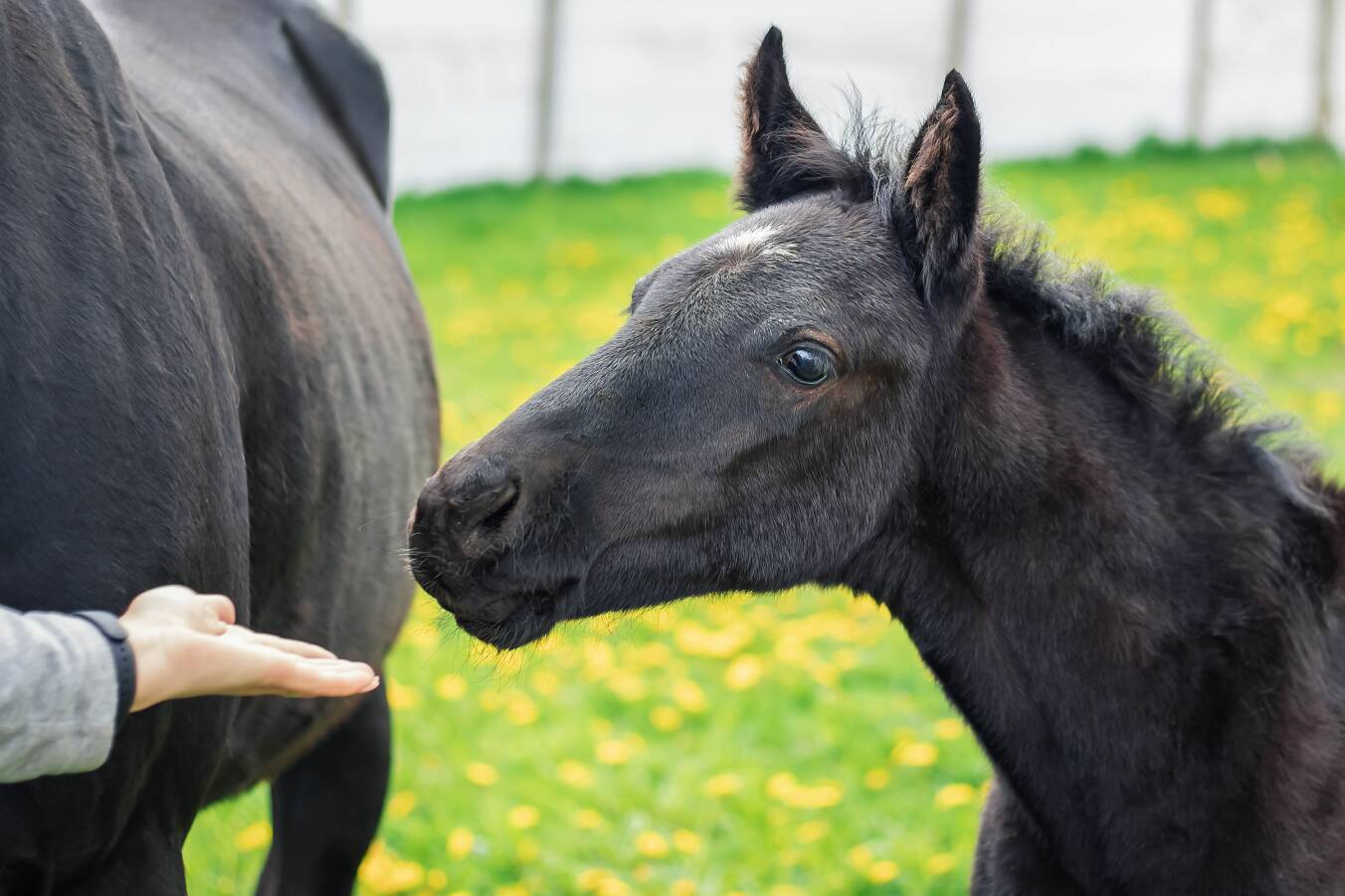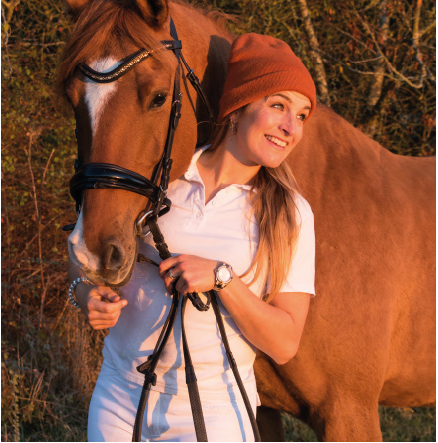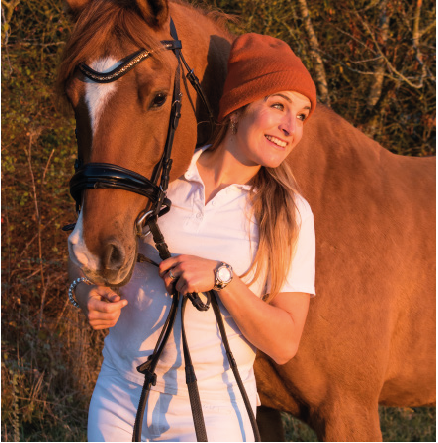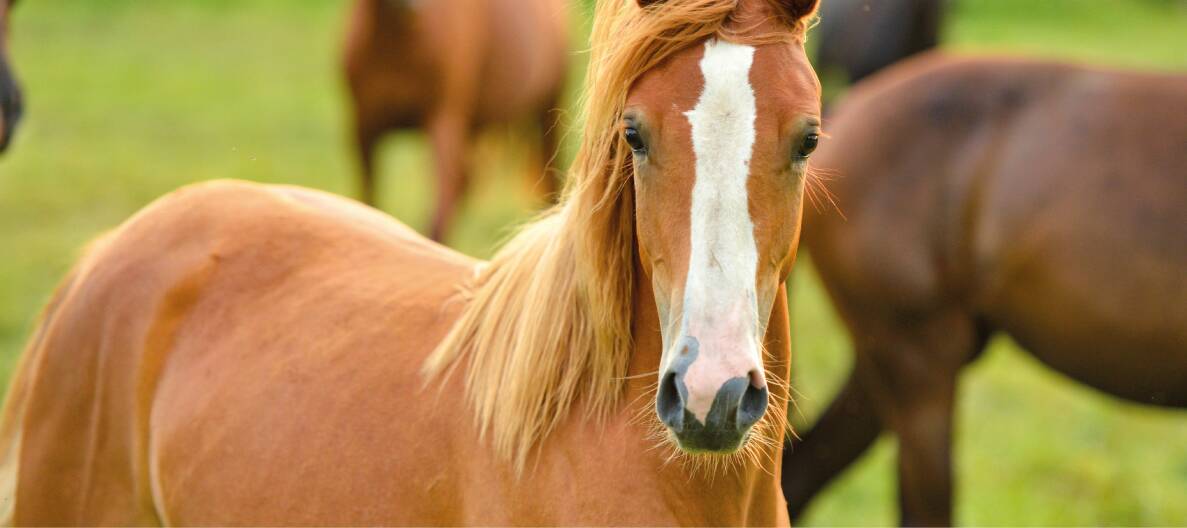Create trust and then invite your foal to train and have fun with you.

I do this by taking a soft rope and putting it on the foal’s nose ridge and asking it to move its weight back. As soon as the foal moves its weight back, I will be precise in my timing, move the small pressure and praise with words or a treat.
I will ask the foal to do it again and again and slowly ask for a retreat. For some horses, backing up is crossing a boundary and it is actually a submission exercise. I will never back up too much with an insecure horse or foal as I want a confident horse.
Next, I will work with our go-signal or forward-signal. I will put a soft halter on the foal and stand next to it. I will ask a helper to stand with the mare a little in front of us. The helper should be aware of my forward-signal and go forward when I ask for it.
As soon as the foal moves forward, we can praise and ask for a stop. At stop, there is another praise for the well-behaved foal. Remember to repeat the exercise a few times. You can also increase the difficulty by doing the exercise again without the helper. Remember, that the time you put in now, is time gained in the later training and the transition to becoming a ridden horse.
Mikado with soft poles
1. The horse should learn:
2. To be aware of all four legs, not just the front legs
3. To walk independently and confidently through something unknown
4. To lift its legs over poles and use its entire body to work through a task
5. To connect brain and body
6. To move forward at my signal
Once your foal knows how the signal to move forward works, you can now play together by sending it through different exercises and tasks.
I love the Mikado exercise because I don’t have to decide where the horse places its feet, or which way it goes through the exercise. Your foal should think of a way through on its own and you shouldn’t lead the way. It gives your foal something to think about, and it will get a sense of where its long legs should be placed.
I prefer soft poles for young horses, which have soft hooves and bones. Nothing happens if the foal steps on the poles and it will prevent incorrect twists and turns on the legs from happening.
If a young horse is rushing through, you can ask it to slow down and walk carefully. Make your hands soft and send it through the exercise gently. Let it lower its head and explore the obstacle and give it time to think.
Follow your heart
It’s the art of limitations to write about exercises, as there is so much to choose from. It’s simply not possible to cover all the exercises that I look forward to training myself. Therefore, I just want to remind you that all horses have different needs and challenges, which is why it is important to listen to yourself and your horse. If there are exercises that you love to do together, then they are the right exercises for you, no matter what others think.

Different surfaces The horse must learn:
1. To move forward on something unknown
2. To trust the rider
3. To trust itself
This is an exercise where the foal will walk on different types of surfaces.
When the surface becomes softer or changes character, it will give the foal a signal to be careful. If our horses still lived freely in the wild, it would be the ones being careful that would survive, as they naturally would avoid swampy areas or areas that could cause them harm. In the wild, injuries to the legs often mean death.
So we must remember, that exercises of this kind are unnatural, and I would never start this exercise without having the relationship between foal and handler established first. What I am asking for, is that the horse will trust me more than a thousand years of instincts. Therefore, always be careful and do not pressure the young horse or foal for too long, as this can lead to unnecessary conflicts.
There are several benefits to teaching your horse to walk on different surfaces and it can provide a good foundation for the future. For example when you need to load your horse, go through a muddy path, have your horse on new arena surfaces, have your horse cross patches on the road, and many more situations. It is in all of these situations that it is essential for your horse to trust you.
Obedience or curiosity?
Before you start training with your foal, I want to ask you a question: Would you rather be invited to a party or be told that you have to come?
The reason for my question is that I believe there is too much horse training that is based on telling the horse what to do, and expecting it to do the correct thing right away.
This rather traditional training approach has been around for a long time, but I would like to challenge it, so that you can get started with your foal or young horse with the correct intentions.
This does not mean that I don’t get my horses to do all sorts of things in the arena or at competitions that are actually unnatural for them. But the majority of my training with my horses is an invitation to different exercises. Some examples could be: ‘Can you turn your shoulder in?’, ‘Can you put more weight on your hindquarters?’, ‘Can you come up on the ramp to the trailer?’ You can surely think of more things you want to do with your young horse. An invitation to our training or play can give us plenty of fun hours together.
It may sound vague or at least the opposite of being dominant. But I am a lead - a clear person who invites my horses to train and play with me. I am not in danger. On the contrary, I think the danger arises when we lure and pressure the horse into something it is not ready for. But it does require that you are clear in what you want from your horse and that you have confidence in yourself. In this way, your horse will be much more motivated to follow you. It is with this mindset that you should go play with your foal and prepare your young horse for riding. The relationship you create between yourself and your foal is very important for your future cooperation.
Basic signals go - stop - go and back up
1. The horse should learn:
2. To be led by a handler
3. To listen to the small signals from the handler
4. That the pressure is released, once the horse gives in
A foal can learn all the basic signals preparing it for its ridden career, if you consider your management well.
Before you work with halters and lead ropes on your foal, start working with your own hands first. Although you may not notice it, you are sending signals through the lead rope with the strength you have in your hands. You can borrow an already schooled horse and notice what happens between you when you tighten and hold tight on the lead rope opposite when you make your hands soft, relaxed and aware instead of tight. It should be with soft hands that you take care of your foal.
I would like to gently teach my foal to back up with a pressure on the nose.
I am planning for my mare Karo to have a foal soon and the plan is to keep the foal. There is a lot I would like to teach the foal before it hopefully becomes a great riding horse. I want to play with a target, do nosework and develop the foals’ muscles and bones so they are healthy and strong and have lots of movement and freedom.
It requires a lot of training to do this. Therefore, I have chosen four exercises which can benefit foals and young horses. I hope that you can use these exercises even before you start riding.
It is exciting to get a foal or a young horse that you can connect with before starting your training. I love teaching both horses and riders new ways to train and new ways to feel. In this article I will give you some basic exercises to ensure that you and your foal, or young horse, will get off to a good start.


I do this by taking a soft rope and putting it on the foal’s nose ridge and asking it to move its weight back. As soon as the foal moves its weight back, I will be precise in my timing, move the small pressure and praise with words or a treat.
I will ask the foal to do it again and again and slowly ask for a retreat. For some horses, backing up is crossing a boundary and it is actually a submission exercise. I will never back up too much with an insecure horse or foal as I want a confident horse.
Next, I will work with our go-signal or forward-signal. I will put a soft halter on the foal and stand next to it. I will ask a helper to stand with the mare a little in front of us. The helper should be aware of my forward-signal and go forward when I ask for it.
As soon as the foal moves forward, we can praise and ask for a stop. At stop, there is another praise for the well-behaved foal. Remember to repeat the exercise a few times. You can also increase the difficulty by doing the exercise again without the helper. Remember, that the time you put in now, is time gained in the later training and the transition to becoming a ridden horse.

Mikado with soft poles
1. The horse should learn:
2. To be aware of all four legs, not just the front legs
3. To walk independently and confidently through something unknown
4. To lift its legs over poles and use its entire body to work through a task
5. To connect brain and body
6. To move forward at my signal
Once your foal knows how the signal to move forward works, you can now play together by sending it through different exercises and tasks.
I love the Mikado exercise because I don’t have to decide where the horse places its feet, or which way it goes through the exercise. Your foal should think of a way through on its own and you shouldn’t lead the way. It gives your foal something to think about, and it will get a sense of where its long legs should be placed.
I prefer soft poles for young horses, which have soft hooves and bones. Nothing happens if the foal steps on the poles and it will prevent incorrect twists and turns on the legs from happening.
If a young horse is rushing through, you can ask it to slow down and walk carefully. Make your hands soft and send it through the exercise gently. Let it lower its head and explore the obstacle and give it time to think.
Follow your heart
It’s the art of limitations to write about exercises, as there is so much to choose from. It’s simply not possible to cover all the exercises that I look forward to training myself. Therefore, I just want to remind you that all horses have different needs and challenges, which is why it is important to listen to yourself and your horse. If there are exercises that you love to do together, then they are the right exercises for you, no matter what others think.
Create trust and then invite your foal to train and have fun with you.

Different surfaces The horse must learn:
1. To move forward on something unknown
2. To trust the rider
3. To trust itself
This is an exercise where the foal will walk on different types of surfaces.
When the surface becomes softer or changes character, it will give the foal a signal to be careful. If our horses still lived freely in the wild, it would be the ones being careful that would survive, as they naturally would avoid swampy areas or areas that could cause them harm. In the wild, injuries to the legs often mean death.
So we must remember, that exercises of this kind are unnatural, and I would never start this exercise without having the relationship between foal and handler established first. What I am asking for, is that the horse will trust me more than a thousand years of instincts. Therefore, always be careful and do not pressure the young horse or foal for too long, as this can lead to unnecessary conflicts.
There are several benefits to teaching your horse to walk on different surfaces and it can provide a good foundation for the future. For example when you need to load your horse, go through a muddy path, have your horse on new arena surfaces, have your horse cross patches on the road, and many more situations. It is in all of these situations that it is essential for your horse to trust you.
Obedience or curiosity?
Before you start training with your foal, I want to ask you a question: Would you rather be invited to a party or be told that you have to come?
The reason for my question is that I believe there is too much horse training that is based on telling the horse what to do, and expecting it to do the correct thing right away.
This rather traditional training approach has been around for a long time, but I would like to challenge it, so that you can get started with your foal or young horse with the correct intentions.
This does not mean that I don’t get my horses to do all sorts of things in the arena or at competitions that are actually unnatural for them. But the majority of my training with my horses is an invitation to different exercises. Some examples could be: ‘Can you turn your shoulder in?’, ‘Can you put more weight on your hindquarters?’, ‘Can you come up on the ramp to the trailer?’ You can surely think of more things you want to do with your young horse. An invitation to our training or play can give us plenty of fun hours together.
It may sound vague or at least the opposite of being dominant. But I am a lead - a clear person who invites my horses to train and play with me. I am not in danger. On the contrary, I think the danger arises when we lure and pressure the horse into something it is not ready for. But it does require that you are clear in what you want from your horse and that you have confidence in yourself. In this way, your horse will be much more motivated to follow you. It is with this mindset that you should go play with your foal and prepare your young horse for riding. The relationship you create between yourself and your foal is very important for your future cooperation.
Basic signals go - stop - go and back up
1. The horse should learn:
2. To be led by a handler
3. To listen to the small signals from the handler
4. That the pressure is released, once the horse gives in
A foal can learn all the basic signals preparing it for its ridden career, if you consider your management well.
Before you work with halters and lead ropes on your foal, start working with your own hands first. Although you may not notice it, you are sending signals through the lead rope with the strength you have in your hands. You can borrow an already schooled horse and notice what happens between you when you tighten and hold tight on the lead rope opposite when you make your hands soft, relaxed and aware instead of tight. It should be with soft hands that you take care of your foal.
I would like to gently teach my foal to back up with a pressure on the nose.
I am planning for my mare Karo to have a foal soon and the plan is to keep the foal. There is a lot I would like to teach the foal before it hopefully becomes a great riding horse. I want to play with a target, do nosework and develop the foals’ muscles and bones so they are healthy and strong and have lots of movement and freedom.
It requires a lot of training to do this. Therefore, I have chosen four exercises which can benefit foals and young horses. I hope that you can use these exercises even before you start riding.
It is exciting to get a foal or a young horse that you can connect with before starting your training. I love teaching both horses and riders new ways to train and new ways to feel. In this article I will give you some basic exercises to ensure that you and your foal, or young horse, will get off to a good start.

